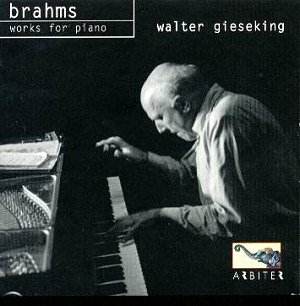AVAILABILITY
www.arbiter.com
A mix of live and commercial recordings the main focus
of curiosity, I think, will be the (admittedly truncated) Brahms Concerto.
The first two movements have been preserved from a passionate performance
given in July 1944 and the tapes had lain in a radio archive in the
then East Germany. Elsewhere the Capriccio derives from a Seattle, Washington
recital given a scant few months before Gieseking’s death in 1956 and
the F minor Sonata dates from 1948 and the source is not disclosed.
The Intermezzi are long established – if perhaps less well known – Gieseking
benchmarks and the advantage of this reissue is that Arbiter have utilised
some of the pianist’s own vinyl test pressings of the 1939 New York
discs.
The Concerto is a strong, powerful and intensely communicative
performance liberally littered with a flurry of dropped notes. It opens
in agitated style – dynamically and rhythmically – and soon takes on
a visceral incision and sense of vertical drama. There are myriad little
revealing details in the left hand for example and even if Gieseking’s
right hand runs are smudged and notes elided or slid over there is still
a sense of the combustible importance of the music, the fact that it
becomes vested with dramatic meaning. The string portamenti that Heger
encourages at the start of the second movement Allegro appassionato
– and a strongly bulging collective vibrato not even then encountered
often – mark out more specifics of the performance’s intensity. Again
Gieseking, who sounds on utterly, indeed quiveringly high-strung form,
drops notes aplenty as he goes (this is not a performance for the admirer
of note perfect renditions). But there is profound characterisation
as well and the string sonorities grow rich in leonine strength. It’s
true that Gieseking speeds up alarmingly - but there is a decisive,
powerful conclusion. Whatever the cause might have been this is a fascinatingly
engaged document.
The Sonata was recorded in September 1948 and is a
strong, quick, again digitally imperfect performance, but this time
considerably less satisfying. The opening movement is very emphatic,
with numerous dropped notes (and very occasional overload in the recording)
and by the crest of the movement and coda the playing is really only
approximate at best. The slow movement is much better, its narrative
suggested with affectionate lyricism and depth but the Scherzo is inclined
to be rather gruff (but with a good central section). In the concluding
Allegro moderato ma rubato, he displays considerable weight and wit
and some marvellous rhythm and even if the climax is fudged one can
sense what an idealised Sonata performance could be – because for all
its manifold imperfections this is an exceptionally expressive performance.
I admired the 1939 Intermezzi very much. The flowing delicacy of the
B flat, Op. 76 No. 4, is notable as is the deeply powerful sense of
incipient tragedy generated in the E flat minor, Op. 118 No. 6, perhaps
the best example of Gieseking’s way with these pieces.
The transfers have been carried out with real skill
and the notes usefully quote some of Gieseking’s own thoughts on interpretation.
That he could be fiery and dramatic we have long known (his live Rachmaninov
Concerto performances have long since startled for their remarkable,
and to some unexpected, power) and this Brahms Concerto confirms it
even more strikingly.
Jonathan Woolf
